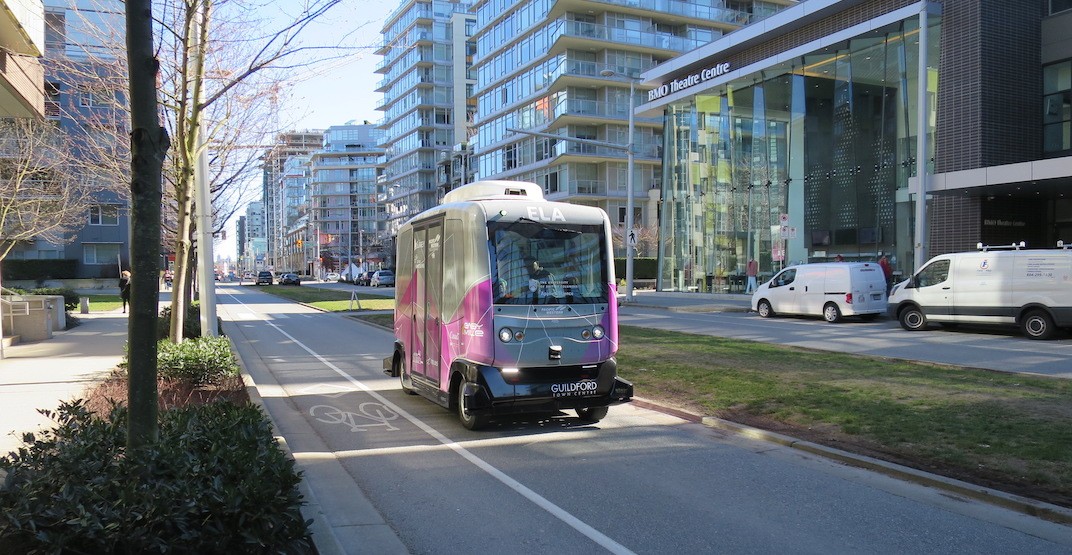Driverless electric shuttles coming to UBC Vancouver campus in 2022

Students, staff, and residents of the University of British Columbia (UBC) Vancouver campus will benefit from a new way to get around starting next year, when a high-tech, automated electric shuttle vehicle pilot project hits the pavement.
BCAA is spearheading a free shuttle service for the public using driverless vehicles, in partnership with UBC and Rogers Telecommunications as a research opportunity, and with Transport Canada providing funding.
- You might also like:
- Vancouver and Surrey both lose bid for $50M funding to build new driverless shuttle routes
- UBC to Surrey private express shuttle service quietly shuts down
- UBC switches to new operator for campus bike share
- 92% of Metro Vancouver residents support UBC SkyTrain: TransLink survey
- TransLink ridership continues to rebound, but bus service cuts forthcoming
Two routes using EasyMile’s EZ10 model of autonomous shuttles will be operated for the pilot project.
Route 1 would travel north-south along the pedestrian pathway through the sports hub on Varsity Fields, between Thunderbird Boulevard and West 16th Avenue — from Thunderbird Parkade and Doug Mitchell Thunderbird Sports Centre to Wesbrook Village.
Route 2 would also provide north-south connections, running a length of about 2.2 km on East Mall between University Boulevard — the core of the academic campus — and Stadium Road. There would be a total of eight stops for Route 2, including UBC Bookstore, Hospital Lane, Brimacombe Building, Thunderbird Boulevard intersection, and north of the Stadium Road intersection.

BCAA Shuttle routes map: Route 1 (red) and Route 2 (yellow). (Daily Hive/Google Maps)

Route 1: UBC’s Varsity Fields’ pedestrian pathway, looking north from West 16th Avenue and Wesbrook Village. (Google Maps)

Route 2: UBC’s East Mall looking south from University Boulevard and UBC Bookstore. (Google Maps)
While the EZ10 vehicles are automated, they will still be manned by an operator. The vehicles will operate at low speeds and have a capacity for six seated passengers.
The BCAA Shuttle will operate over a 12-month period from Mondays to Fridays, between 8 am and 6 pm. The estimated frequency is every 12 to 18 minutes.
Given the nature of the project, and the involvement of the federal government through Transport Canada, the project is expected to receive its necessary final approvals.
TransLink staff have already reviewed the project, and deemed it outside of their Independent Transit Service (ITS) classification, given that the shuttle’s primary purpose is for research, not general mobility.
ITS services are essentially private transit or shuttle bus services that are spearheaded, fully self-funded, and operated by municipal governments, private operators, or other entities. All applications for ITS are regulated and reviewed by TransLink, which makes its decisions based on whether the proposed service could have a negative competing impact on the ridership and finances of its public transit services.
Examples of ITS previously approved by TransLink include free summer-time shuttles in Richmond, the Tri-Cities, and White Rock, and the short-lived, private Beyond-Shuttle service from Surrey to UBC.
As the BCAA Shuttle is not considered under ITS, TransLink staff have noted that the public transit authority does not have the powers to regulate the service. But staff have indicated they are interested in seeing the results of the pilot project, given that automation is seen as a long-term eventuality for buses under Transport 2050.
However, BCAA and UBC will require an amendment or exception by the provincial government, so that the automated service complies with the framework of the BC Motor Vehicle Act.

EasyMiles’ EZ10 driverless shuttle in Vancouver’s Olympic Village, 2019. (Kenneth Chan/Daily Hive)

EasyMiles’ EZ10 driverless shuttle in Vancouver’s Olympic Village, 2019. (Kenneth Chan/Daily Hive)
The same model of high-tech, automated electric shuttle vehicles first made their appearance in Metro Vancouver in 2019, as a free technological demonstration as part of the City of Vancouver and City of Surrey’s joint partnership for Infrastructure Canada’s Smart Cities Challenge.
In early 2019, EZ10 vehicles operated in Vancouver’s Olympic Village along West 1st Avenue from Manitoba Street to Olympic Village Station, and made looping demonstration rides within Surrey’s Civic Plaza.
However, Vancouver and Surrey were ultimately unsuccessful with their bid to the federal government on building Canada’s first two collision-free multimodal corridors with driverless vehicles.
Previous Canadian demonstrations of EasyMile’s vehicles were conducted between Calgary Zoo and Telus Spark, as well as within a Montreal suburb and Montreal Olympic Park.
During the 2020 Olympic and Paralympic Games in Tokyo, a demonstration automated shuttle bus was operated in the Athletes Village by Toyota. The service was suspended halfway into the Paralympics, after the automated shuttle hit and injured a visually impaired Paralympic athlete — even though an operator was at the controls, and Toyota’s e-Palette model of vehicle was traveling at slow speeds.
- You might also like:
- Vancouver and Surrey both lose bid for $50M funding to build new driverless shuttle routes
- UBC to Surrey private express shuttle service quietly shuts down
- UBC switches to new operator for campus bike share
- 92% of Metro Vancouver residents support UBC SkyTrain: TransLink survey
- TransLink ridership continues to rebound, but bus service cuts forthcoming

